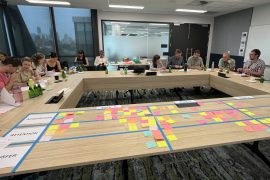In 2024, the Support for Students Policy introduced early feedback tasks across all 1000-level units at the University of Sydney. These tasks aim to identify students at risk of failure and provide targeted support before the census date. Early, low-stakes assessment and feedback offer multiple benefits, allowing students to adjust their study strategies and improve performance in subsequent assessments.
Designing a meaningful feedback task for early in the semester when limited content has been covered, can be challenging. In this article, I chat with Senior Lecturers James Humberstone and Carla Trott, who share their approach to designing and implementing an authentic early feedback task in MUED1005: Key Approaches in Music Education. This core unit in the Bachelor of Music (Music Education) degree prepares students for professional careers teaching music in schools.
River Torrington: To get us started, can you tell us about how you designed the Early Feedback Task for MUED1005?
James Humberstone: I’ve tried to make the task real and deep, focused on embodied music learning rather than rote learning of surface knowledge. It was also designed to be low-pressure to avoid harm to students.
Carla Trott: James’ careful design ensured that the task was meaningful and relevant to the class content and assessment, achievable within the short teaching period, and designed to help students succeed.
River: What did your Early Feedback Task look like?
James: The task was a video assignment in which students recorded themselves singing solfege notes while hand-signing the melody, as if they were teaching in a classroom. This gave them a taste of the first major assessment in a low-stakes environment and helped us identify and give feedback to students with weaker skills earlier in the unit.

Carla: In the first two weeks of class, I scaffolded the submission by breaking down each component of the task and explicitly demonstrating and rehearsing it with the students. This not only provided clear explanations of what I expected, but also helped with student confidence in the task. Students were very engaged with these practice opportunities. The EFT didn’t impose on my teaching time, but rather was an excellent way to check for learning, check for commitment to the subject and be reminded (when marking) of the student’s names and faces early on in the course!
River: One challenge with having a manually marked early feedback task is completing the marking in time to send students emails in Week 4. How did you manage this?
James: We used a detailed rubric that broke down the criteria into increments from Fail to High Distinction, which was quick to mark in Canvas Speedgrader. It only took me an hour to mark every single submission with this small cohort. I’ve also marked a similar early feedback task for MUED1010 in class contemporaneously. Marking students on the rubric, in combination with my individual feedback comments, helped students understand why they got the marks they did and ensured they knew what they needed to do to improve. Having a detailed rubric also reduces the risk of students contesting their marks.
River: Would you change anything about this early feedback task for next time?
James: Next time, I’d personalise my welcome email sent through SRES to make it sweeter and more encouraging.
River: Do you have any other thoughts you’d like to share about your early feedback task?
James: Another positive outcome of the early feedback task and the associated emails was that every student engaged in Canvas and completed the task on time, which is remarkable for a first-year student cohort.
Carla: This task helped students start thinking about musicianship in a new way, particularly from the perspective of a music teacher. It encouraged them to consider how they ‘present’ with their whole body – their voice and face – and it served as a taster for the teaching that comes later.
Allowing students to demonstrate their embodied music knowledge and individual voice was very powerful as it was so well aligned with the practice of being an engaging music teacher.
River: Thank you for sharing your approach to the early feedback task!
Top tips for designing effective Early Feedback Tasks (EFTs)
If you are looking to introduce meaningful and manageable Early Feedback Tasks (EFTs) into your own unit, consider these tips from James and Carla’s experience:
- Align the task with unit objectives, ensuring that you design the task to meet clear learning outcomes.
- Use the early feedback task to scaffold skills that students need for other assessments.
- Look for opportunities to make the early feedback task authentic, in other words, meaningful and relevant to students’ lives or future careers.
- Use in-class practice opportunities and/or exemplars to help clarify the requirements and expectations of the task.
- Provide meaningful, actionable feedback that lets students understand their academic performance in relation to unit expectations and how to improve their performance in subsequent assessments.
Want to learn more?
For additional resources and support on EFTs:
- Explore the early feedback task resources in the Teaching Resources Hub
- Connect with your faculty contacts in the Teaching Resources Hub for discipline-specific guidance.
You can also share your own EFT strategies by contributing to Teaching@Sydney.





